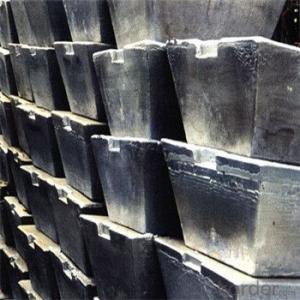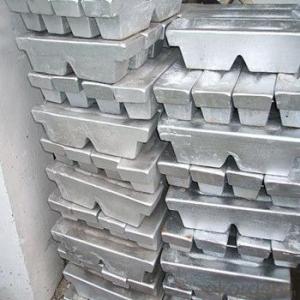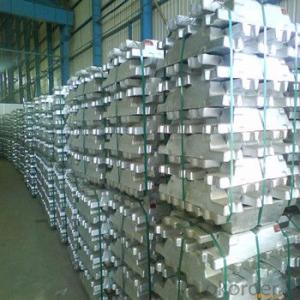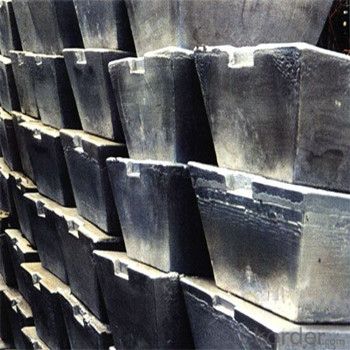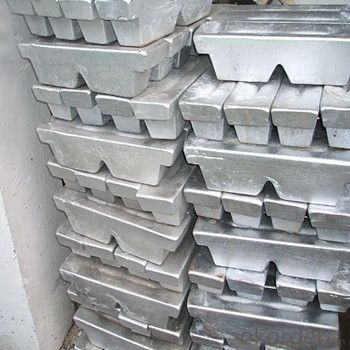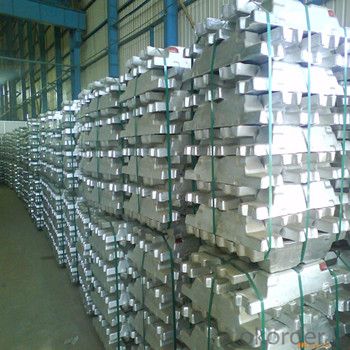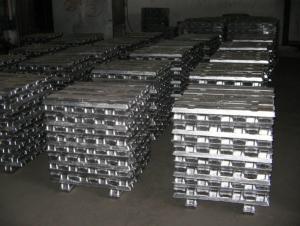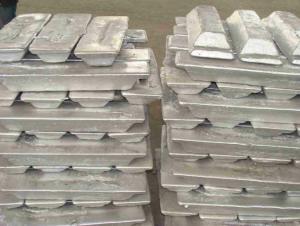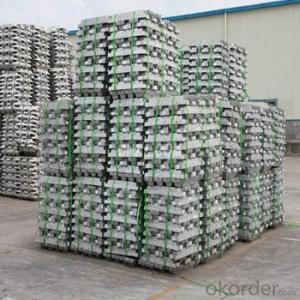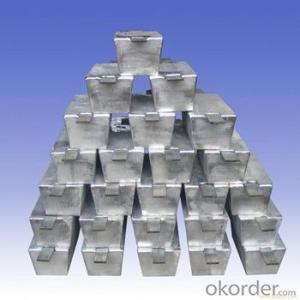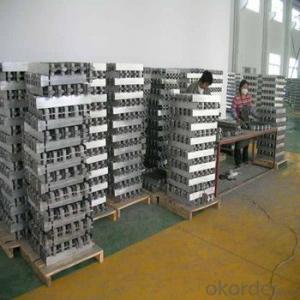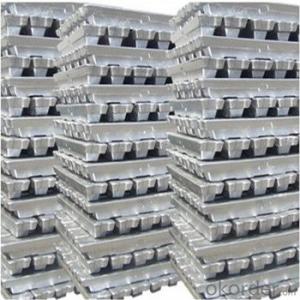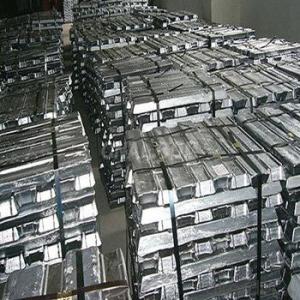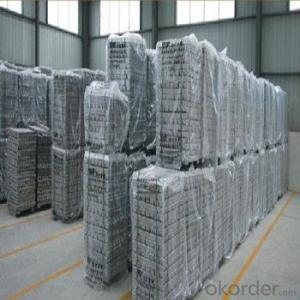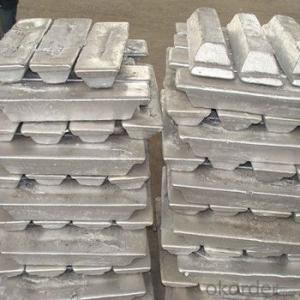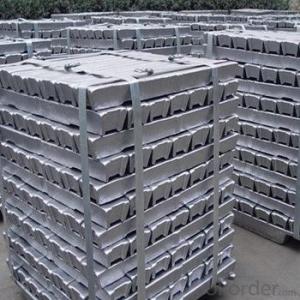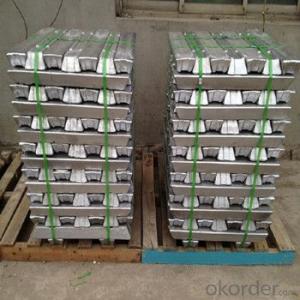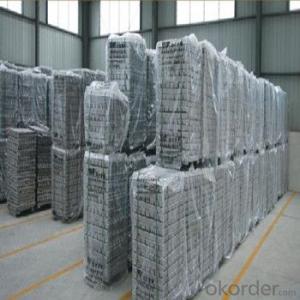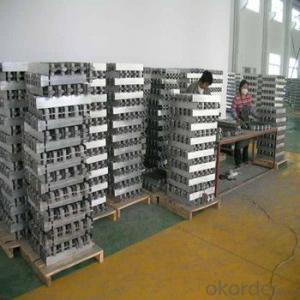Aluminum Pig/Ingot With High Purity And Low Price
- Loading Port:
- China main port
- Payment Terms:
- TT OR LC
- Min Order Qty:
- 5000 m.t.
- Supply Capability:
- 100000 m.t./month
OKorder Service Pledge
OKorder Financial Service
You Might Also Like
Pure Aluminum Pig/Ingot Used for Industry
1.Structure of Aluminum Pig/Ingot
A material that has been cast into a shape in order to be transported and processed easier than in an unprocessed form. An ingot is typically rectangular in shape, which allows it to be stacked. Ingots are most commonly associated with metals, with ingots of gold held in the vaults of banks and brokerages being popular images.
Aluminum Ingot is with the AL as the main chemical composition.Aluminum Ingot is used for industry,such as automobile,pinning and weaving,electron broadly and so on. Aluminum Ingot has the following advantages: easy control and operation, fast melting.
2.Main Features of the Aluminum Pig/Ingot
•High Purity
•Easy control and operation
•High strength
•Fast melting
•Competitive price
•Best Service
3.Aluminum Pig/Ingot Images
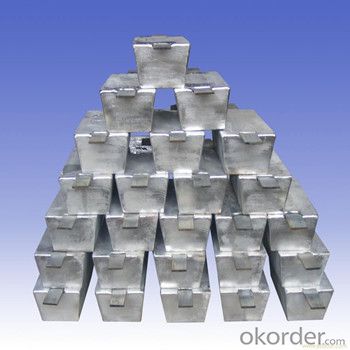
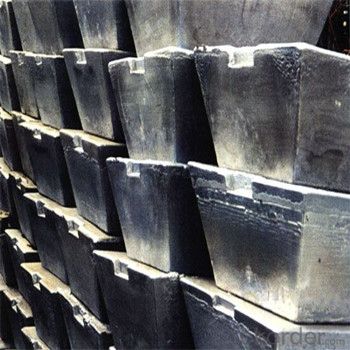
4.Aluminum Pig/Ingot Specification
Grade | Chemical Composition % | |||||||||
Al≥ | impurities ≤ | |||||||||
Si | Fe | Cu | Ga | Mg | Zn | Mn | others | Sum | ||
Al99.9 | 99.90 | 0.50 | 0.07 | 0.005 | 0.02 | 0.01 | 0.025 | - | 0.010 | 0.10 |
Al99.85 | 99.85 | 0.80 | 0.12 | 0.005 | 0.03 | 0.02 | 0.030 | - | 0.015 | 0.15 |
Al99.7 | 99.70 | 0.10 | 0.20 | 0.010 | 0.03 | 0.02 | 0.030 | - | 0.030 | 0.30 |
Al99.6 | 99.60 | 0.16 | 0.25 | 0.010 | 0.03 | 0.03 | 0.030 | - | 0.030 | 0.40 |
Al99.5 | 99.50 | 0.22 | 0.30 | 0.020 | 0.03 | 0.05 | 0.050 | - | 0.030 | 0.50 |
Al99.00 | 99.00 | 0.42 | 0.50 | 0.020 | 0.03 | 0.05 | 0.050 | - | 0.050 | 1.00 |
5.FAQ of Aluminum Pig/Ingot
We have organized several common questions for our clients,may help you sincerely:
①How about your company?
A big and famous and professional manufacturer & supplier of Aluminum Pig/Ingot, is one of the one of the large-scale professional investment Aluminum Pig/Ingot production bases in China.It have focuses on producing the Aluminum Pig/Ingot production for many years and gotten rich experience.Annually lagrge amount of Aluminum Pig/Ingot production are exported to markets in Europe,America and Japan. The quality and service have also gotten OEM service is available according to customer’s requirements.
②How to guarantee the quality of the products?
We have established the international advanced quality management system,every link from raw material to final product we have strict quality test;We resolutely put an end to unqualified products flowing into the market. At the same time, we will provide necessary follow-up service assurance.
③How long can we receive the product after purchase?
In the purchase of product within three working days, We will arrange the factory delivery as soon as possible. The pecific time of receiving is related to the state and position of customers.Commonly 7 to 10 working days can be served.
- Q: Can aluminum ingots corrode?
- Yes, aluminum ingots can corrode.
- Q: What is the role of aluminum ingots in the production of foils?
- The production of foils heavily relies on aluminum ingots. Foils, which are primarily made of aluminum, are known for their lightweight, strength, and resistance to corrosion. The process of making foils begins with melting the aluminum ingots. When the ingots are heated to a high temperature, they transform into a liquid state. This liquid aluminum is then poured into thin slabs, which are subsequently rolled and reduced in thickness using rolling mills. The rolling mills require aluminum ingots to carry out the rolling process. The ingots are fed into the mills, where they undergo continuous compression and elongation. As a result, they are transformed into thin sheets with a consistent thickness. The ingots act as a reliable source of aluminum throughout the rolling process, ensuring a steady supply of material. The quality and characteristics of the resulting foils are directly influenced by the composition and purity of the aluminum ingots. High-quality ingots with minimal impurities lead to foils with excellent surface finish, superior strength, and enhanced corrosion resistance. Moreover, the size and dimensions of the aluminum ingots determine the size and dimensions of the foils produced. Larger ingots enable the production of wider and longer foils, while smaller ingots are suitable for narrower and shorter foils. In conclusion, aluminum ingots are the essential starting point and primary material in the foil production industry. They are melted, cast, and rolled into thin sheets, providing the necessary aluminum for the manufacturing process. The quality, purity, and size of the ingots directly impact the quality and characteristics of the resulting foils, making them a critical component in the industry.
- Q: What are the basic equipments for the production of aluminium ingots?
- If you want to match the very homogeneous ingot aluminum melting furnace, automatic machine, automatic folding spindle machine, environmental protection equipment, forklift, spectrum analyzer, loadometer, refining machine etc..
- Q: Can you melt the aluminium ingot?
- Cans and cans and rings are aluminium alloys with different compositions. The tank is made of aluminium alloy coil and punched out each plate first, and then the wafer is deep washed into a tank.
- Q: How is aluminum ingot different from aluminum billet?
- Aluminum ingots and aluminum billets are two variations of aluminum metal that vary in terms of their form, dimensions, and manufacturing techniques. Typically, aluminum ingots are produced through a primary aluminum production method known as smelting. These ingots are solid blocks or slabs of aluminum with a standardized shape and size, resembling a large rectangle. The production process involves pouring molten aluminum into a mold and allowing it to cool and solidify. Aluminum ingots serve as essential raw materials for subsequent processing, including rolling, extrusion, or forging, enabling the creation of diverse aluminum products. On the other hand, aluminum billets are semi-finished goods that are often derived from aluminum ingots. The creation of billets involves heating and continuously casting molten aluminum into a cylindrical form, which is then cooled and solidified. Unlike ingots, billets possess a smaller cross-sectional area and a longer length. They are primarily employed as starting materials for extrusion processes. In these processes, billets are heated and pushed through a die, enabling the production of intricate shapes such as rods, bars, profiles, or tubes. In conclusion, despite being composed of the same material, aluminum ingots and aluminum billets differ in their form, dimensions, and purpose. Ingots serve as large rectangular blocks, utilized as raw materials for further processing, while billets are smaller cylindrical shapes employed as the initial materials for extrusion processes.
- Q: How much is a ton of aluminium ingot on the market?
- Anshan executive director and Secretary of the board of directors pay Kyrgyzstan will accept the inquiry said that Liaoning province is not affected by the snowstorm blowing, the Anshan Iron and steel production line is operating normally, although from Shanxi coal supply tensions, but from Heilongjiang normal supply, so the company can make proper deployment, to meet the needs. However, Fu Ji will say that the snow storm caused some traffic in the sales market to be confused and could not be paid on time.
- Q: What can aluminium ingots do?
- Cast aluminium and aluminum alloy are used to produce aluminium castings by casting method. Wrought aluminium and aluminium alloy are produced by pressure process. They are plates, belts, foils, tubes, rods, shapes, wires and forgings.
- Q: What are the energy requirements for producing aluminum ingots?
- Several factors, such as the production process, energy source, and facility efficiency, can influence the energy requirements for producing aluminum ingots. Generally, the production of aluminum ingots is known to be an energy-intensive process. The primary method used to produce aluminum ingots involves smelting aluminum oxide, or alumina, obtained from bauxite ore. The most commonly used method is the Hall-Héroult process, which includes electrolyzing alumina dissolved in a molten cryolite electrolyte. To carry out this process, a significant amount of energy is needed to heat the alumina to its melting point of approximately 2,040 degrees Celsius and maintain this temperature. Typically, large electric currents are passed through the molten electrolyte to provide the necessary energy for electrolysis. Moreover, the production of aluminum ingots requires a substantial amount of electrical energy to break the chemical bonds in alumina and separate the aluminum metal from the oxygen. The electrolysis process consumes significant electricity, making aluminum production one of the largest global consumers of electrical energy. The source of electricity used can also influence the energy requirements for producing aluminum ingots. Utilizing renewable energy sources like hydropower, wind power, or solar power can significantly reduce the environmental impact and carbon footprint of aluminum production. Conversely, if non-renewable sources like coal or natural gas are used to generate electricity, the energy requirements may increase, contributing to higher greenhouse gas emissions. Over the years, efficiency improvements and technological advancements have been made in aluminum production processes, resulting in reduced energy consumption. For instance, the introduction of pre-baked anode technology has enhanced the energy efficiency of the Hall-Héroult process. Additionally, recycling aluminum requires significantly less energy compared to primary production from bauxite ore, making it a more sustainable and energy-efficient option. In conclusion, the energy requirements for producing aluminum ingots are significant due to the high temperatures required for smelting and the electricity needed for electrolysis. However, technological advancements and the adoption of renewable energy sources can help decrease energy consumption and minimize the environmental impact of aluminum production.
- Q: Wall aluminum window price
- Now there are all aluminum furniture, aluminum materials, for more information, you can point me
- Q: How can the pop top smelting be purified after the aluminium ingot is smelted?Then sell aluminum ingot raw material suitable?
- Although aluminum prices now have to rise, but now is high, a large number of aluminum ingots, and some hot money funds customs Tun once sold is small, cautious cautious. Crowning calamity.
Send your message to us
Aluminum Pig/Ingot With High Purity And Low Price
- Loading Port:
- China main port
- Payment Terms:
- TT OR LC
- Min Order Qty:
- 5000 m.t.
- Supply Capability:
- 100000 m.t./month
OKorder Service Pledge
OKorder Financial Service
Similar products
Hot products
Hot Searches
Related keywords
